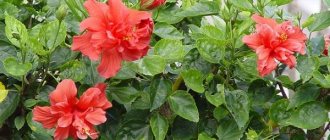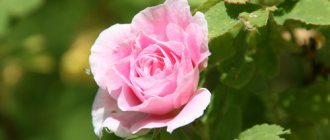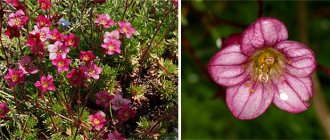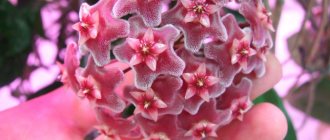Rootstock for standard rose
Rosehip is used as a rootstock for rose trees because it is well adapted to severe frosts. Branches of roses of different varieties are grafted onto its trunk. Their choice depends on the height of the desired standard rose and the shape of the future tree.
Before purchasing a standard rose, it would not hurt to ask the seller what rootstock it is grafted onto. Rose rubiginosa and rose cinnamon are not suitable for these purposes. They produce a lot of growth, the shoots are strewn with sharp thorns, and the growth of the lashes leaves much to be desired.
The trunk of low pink trees will be no more than forty-five centimeters. The height of semi-standard ones ranges from seventy to eighty centimeters.
Standard ones - up to one meter, and weeping types (they are also called cascade) - from a meter to a meter of seventy centimeters. Accordingly, small roses are usually grafted onto low trunks, and larger ones onto tall ones, which looks much more impressive.
There is also an indoor rose tree. But this is an option for an apartment; an elegant rose requires special care. It does not tolerate cold weather and severe frosts. At the first frost the flower will die. Do not confuse indoor rose with hibiscus. Very often it is called an indoor rose. Hibiscus reaches a height of 2 meters and takes up a lot of space, unlike a real miniature indoor rose.
Proper planting of a rose tree in the garden
Planting a standard tree should be timed to coincide with the spring months. The rose can be planted in a permanent place with the onset of stable warmth, in calm, clear weather.
You first need to prepare a seat - dig a hole 70 cm deep, the width of the hole depends on the size of the seedling's earthen ball. If you plan to plant several plants in a group, you should provide a distance between the holes of approximately 1 m.
Saplings
Rose bushes grafted into the root collar must be placed in the hole as follows: the lower part of the graft is buried in the ground, the upper part is located above the soil surface.
When planting, the seedling is immediately tied to a peg, leveling the vertical position of the stem. The support is dug into the ground at a distance of 2 - 3 cm from the main trunk of the rose tree; the height of the support should exceed the height of the seedling. The stem is attached to a support below and under the trunk; if the plant is planted in a ventilated place, all large branches of the trunk must be fixed.
It is recommended to plant the standard rose in a sunny area.
You can stimulate the growth of buds in the crown of a standard rose by wrapping it in burlap or sphagnum moss, which must be periodically moistened. After the buds have germinated, you can remove the burlap.
The ideal place for planting roses is a windless, sunny area without excessive humidity. The high groundwater level at the site where standard roses are planted requires reliable drainage.
Advice! For planting, purchase a standard rose with a closed root system - the crop loses moisture very quickly.
Standard rose: photo, description of varieties
There are certain varieties of roses that gardeners most often choose for grafting into trunks. For “trees”, Grouse and Nozomi are suitable. For those that are weeping, that is, cascading, Ballerina and Canary Bird are good choices.
It is not so easy to choose suitable varieties for small standard trees. If the crown of the rose tree is thickened, it will give the impression of heaviness. And this will not at all decorate the originally intended miracle.
Low trunks are suitable for a small garden or courtyard, and one of the best varieties for them is Knirps. This rose has delicate, pink buds that look elegant on the “leg” of the trunk. Such a rose-tree will look great in the center of a flower garden, in a single copy. It does not need to be supplemented with other colors.
The Immensee variety looks very unusual, like a large but light blooming bouquet. The rose's petals seem to glow, reminiscent of the mother-of-pearl shine of pearl shells.
The variety Catherine Deneuve is also popular and widespread. It has light orange buds. The shape resembles small suns that illuminate the garden and delight the eye, lifting your spirits.
Homemade rose tree (Chinese rose): care at home - 7 simple rules
Caring for Chinese roses at home is not difficult, even beginners can do it. The main thing is to adhere to the rules listed below.
The first rule is that the soil should be light, nutritious and always moist.
You can use ready-made, purchased universal soils for indoor plants, but it is better to prepare the soil yourself at home. To do this, you need to take turf soil, sand and humus in equal proportions. You can add a little peat - it will help retain moisture.
Pour expanded clay (at least 2 cm and no more than 1/4 of the height of the pot) or river pebbles onto the bottom of the pot to retain moisture and prevent acidification of the soil.
Don't forget to periodically loosen the top layer of soil! Roots need air no less than moisture!
The second rule is good lighting and moderate temperature.
The plant loves light and feels good on the balcony or veranda in summer.
Important! Direct sunlight can cause leaf burn! Hibiscus doesn't like drafts!
If there is too much light, the Chinese rose at home will quickly drop its flowers. If it is insufficient, flowering will not be abundant and dirty pink spots may appear on the leaves.
Comfortable temperature for the plant in summer is 18-25 degrees, in winter - 14-18 degrees.
Rule three - moderate watering
The soil should not dry out, otherwise the plant will begin to shed flowers and leaves.
In summer you should water the plant at least twice a week, and in the hottest weather it may require daily watering.
Spraying the leaves is welcome, but you just need to do it in the morning or evening hours, when there is not a lot of sun and water droplets will not focus the sun's rays on themselves (to prevent burns).
In winter, you need to water less often as the top layer of soil dries.
Excessive watering and stagnation of water in the pan are unacceptable, because this can lead to root rotting and fungal diseases.
Water for irrigation should be used that is settled, soft, and at room temperature.
Rule four - mandatory feeding
In the spring-summer period, feed once every 15 days, in winter - once every 30 days.
For a tree to be healthy, strong, and for green leaves, nitrogen is needed; for plant growth, phosphorus is needed; for flowering, potassium is needed.
Hibiscus is susceptible to so-called magnesium chlorosis - the leaves turn light green and the bush loses its beauty. In summer, magnesium supplementation should be increased.
It is best to use universal fertilizers for indoor plants that have a balanced composition of chemical elements. The nitrogen-phosphorus-potassium ratio in it should be 2:1:3. You can use concentrated liquid mineral fertilizer for decorative deciduous and flowering plants from Bona Forte.
Rule five - timely transplantation
Transplantation is done in the spring. The plant needs to be replanted every year for the first three years, then once every 2-3 years. When it reaches a large size, do not replant, but only replace the top layer of soil with a new one.
Each time choose a pot size with a diameter 2 cm larger than the previous one.
Transplantation is carried out using the transshipment method - with a whole earthen lump entwined with roots. Only root-free soil is removed and replaced with new soil.
In case of emergency transplantation (to remove pests or disease-affected roots), free the roots from the soil, remove the diseased ones, and treat them with a light pink solution of potassium permanganate. When filling the pot with soil, ensure that the roots are evenly distributed inside the pot. The soil needs to be slightly compacted. At the end of the replanting, there should be a distance of 2 cm between the top layer of soil and the edge of the pot so that water does not flow out of the pot during watering.
Rule six - correct pruning
Young trees do not need pruning. An adult Chinese rose at home is pruned in early spring (February, March) in order to regulate the size of the plant, to give it a beautiful shape or to stimulate abundant flowering.
Cut the branch at an angle of 45 degrees to the trunk, just above the bud. To stimulate flowering, make a cut after 2-3 buds.
In autumn (September), old, deformed or diseased branches are pruned. The cut area must be sprinkled with charcoal or crushed activated carbon so that pathogenic microorganisms do not enter the plant through it.
Rule seven - disease and pest control
Diseases can occur due to errors in plant care or caused by pests.
Care errors: spots on the leaves, leaves turn yellow and fall off, buds do not form or fall off
- The leaves turn yellow and wither, wrinkle - not enough moisture, dry air,
- leaves turn yellow and fall off - excess water or lack of iron in the soil,
- whitish dry spots - sunburn,
- leaves turn pale - not enough light, lack of nitrogen in the soil,
- buds fall off - lack of moisture, improper feeding or sudden temperature changes,
- buds do not form - lack of potassium in the soil,
- spots on the leaves - lack of magnesium.
How to deal with this? Do everything that is written above in paragraphs 1-6, and these problems will not occur.
Pests: spider mites, aphids, whiteflies, scale insects, gall midges, scale insects
- Spider mite - settles on the underside of the leaf, it is very small and invisible. The affected leaves turn pale, become covered with yellowish specks, and a coating similar to a cobweb appears. To get rid of a tick, you need to spray with a soap solution or a solution with the addition of any essential oil. More radical measures include the drugs Akarin, Fitoverm, Derris, Aktara, Neoron, Fufan, etc. Spray the leaves on both sides;
- Aphids are small insects that live in colonies. Affected leaves curl and sticky droplets appear on them. Methods of control: aphids can be removed mechanically using a cotton swab moistened with a soap solution or a solution of tobacco dust. Then treat with any preparation: Fitoverm, Aktara, Biotlin, Iskra, etc.
- Whiteflies are small adult insects with white wings; the larvae are pale yellow. Affected leaves become covered with sugary secretions, turn yellow and fall off. The leaves should be treated with a solution of potassium soap or the preparations Aktara, Karbofos, Iskra, Fufanon, Biotlin.
- Scale insects and false scale insects settle on the underside of the leaf along the veins in the form of brownish or brown tubercles. Adult insects are covered with a waxy shield. For a more effective effect of the drugs, you must first wipe the leaves with an alcohol solution or kerosene. Then spray with Actellik.
- Gall midge is a small midge that infects leaves and buds, laying eggs in them. The larvae that hatch from them eat the flower bud from the inside. Soon they fall off. If the fallen buds are not removed, the parasite moves into the soil and damages the roots. Control methods include removing falling leaves and buds, treating the soil with any preparation against soil insects, for example “Grom-2”.
- Mealybug (hairy louse) - affects leaves and leaf cuttings. The insect is white and about the size of an aphid. A leaf affected by scale insects looks like it is dusted with flour. These are not only accumulations of insects, but also their sugary secretions. The plant is placed in the shade and treated with Fozalon, Aktara, Actellik, Rogor or Phosfamide sprays.
You can try using folk remedies to combat the listed parasites:
- infusion of fragrant tobacco,
- red pepper or mustard,
- garlic infusion,
- soap solution with alcohol.
Recommended rose varieties
- Princesse de Monaco - cream petals with pink tints.
- Jardins de Bagatelle (Jardin de Bagatelle) - she has pure cream flowers.
- Scarlet Beauty - Marcel Pagnol (Marcel Pagnol).
- Catherine Deneuve, light orange flowers. A beautifully shaped rose tree will fit harmoniously into any garden.
Roses with large inflorescences are suitable for large garden plots. These include New Down. This type of rose tree is popular among gardeners. Planted as a single plant or surrounded by other flowers.
The tree rose of this variety looks great in any case. Its foliage is small, but its mass is large, so the bush looks massive. Against this green background, large light rose buds “shimmer” like stars in the sky.
How to organize a rose garden on your property step by step
To ensure that the flowers in the flowerbed do not lose their beauty, the area must be properly decorated.
Organizing the process step by step will save time and money. In the early stages, you can predict the slightest problems, so you should not abandon the sequence of measures. Rose on a high trunkSource domvpavlino.ru
Flower garden along the fenceSource pinterest.com
Place
For a rose garden in a dacha, you need an area that is as open as possible for viewing. Choose a place in the garden, near the main entrance or in a recreation area. If you hide expensive varieties and a complex structure in a remote corner, then the owners will not be able to enjoy a pleasant view.
An abundance of roses of rich cream color Source botanichka.ru
A capricious flower will not throw out buds if there is a lack of sun. Lack of rays negatively affects the shade intensity, size and health of crops. The bushes are drawn towards the light source and deform unsightly. For roses in landscape design, proximity to thick trees and high fences is contraindicated.
Support for roses in a flower bedSource nashgazon.com
Plants feel uncomfortable near the walls of buildings, especially on the western and northern sides. Unprotected from the bright sun, a rose garden in a dacha withers and burns within a few days. The ideal option for the location of the structure is 4 hours of lighting before and after lunch. Gardeners recommend a southern, windless slope.
The soil
Roses in landscape design develop in an area with fertile soil. Wetlands and options with close groundwater are not suitable. The flower lives without problems in light loam, which has an acidity of pH 5-6 units. Before planting plants in the soil, they dig it up, add fertilizers (organic or mineral), and leave it for 90 days to settle.
Tall arch of pink climbing rosesSource kmgram.com
Plan
If you think about the structure of the rose garden at your dacha in advance, then there will be no problems when planting. Decorative structures and flowers along the paths should not interfere with the movement of people. The parameters of the site and the distance to the nearest structures are noted on paper. The drawing will also help you choose the shades of plants and find optimal neighbors.
Frame with benches for climbing roses Source ooo-metallist.su
There are two types of layouts for roses in landscape design:
- Embossed. Clear boundaries and correct geometric shapes are observed, complex compositions and solo plantings are used. All elements are interconnected and emphasize the beauty of all plants.
- Landscape. The rose garden at the dacha looks like a natural extension of nature. Suitable for small areas.
Style
When decorating a flower garden, always adhere to style. For the ceremonial direction, bright buds and contrasting combinations are chosen. The entrance or path in white and red looks impressive. Yellow-orange roses in landscape design give the space a solemn sound.
Variety of roses in the flower gardenSource studiofmp.com
The romantic style prefers classic varieties and shades and does not like sharp transitions. Pastel colors and gradients from delicate purple to white dominate here. To decorate a flower garden, choose a secluded area or a place that is significant to the owner.
Yellow roses for a bright rose garden in the countrysideSource weibo.com
Cascade rose
For cascading boles, completely different varieties of roses are selected. Paul Noel has lush pink inflorescences and an attractive aroma that can be felt from a distance. Rosarium Vetersen is a variety that is also suitable for this type of trunk; the flowers are bright pink, with a hint of fuchsia, and looks good next to hedges that are neatly trimmed.
If you prefer roses in white shades, pure as pearls, pay attention to the Alba Meidiland variety or Schneewittchen. The second variety has a more delicate and soft color, but it will delight you with flowering shoots longer.
Among the bright colors, we can suggest Leverkusen, which blooms with bright yellow flowers. From the cascade family there is also a classic of scarlet colors - Scarlett Mailandecor. All these varieties, regardless of the color of the rose petals, resemble hanging bright carpets of blooming greenery or fabulous waterfalls. Varieties, of course, play a big role when the future owner chooses such a miracle, but you also need to know how to care for them.
Choosing a support
Standard roses are the “highlight” of any garden and will not leave indifferent even the most capricious beauty gourmet. Speaking about the advantages, we should safely give first place to resistance to weather conditions and less resistance to disease, since the tree is located on a hill, and the rosehip base protects the plant from fungal infections. When the time comes to plant the trunk, be sure to replace the temporary support to which it was attached with the main one - as strong as possible. Because if the bush starts to grow too quickly, its weight will also increase quickly. The support should be slightly lower than the crown and located at a distance of about ten centimeters from the trunk. If you are growing a seedling in a pot, take care of additional fastening so that it is resistant to possible winds.
The best option for supporting a standard rose would be metal or wooden stakes, or rods or fiberglass tubes. It is customary to place the support deep into the ground on the opposite side of the slope. The level of inclination is quite easy to determine - you just need to pay attention to the bend at the base of the plant - its opposite side is what we need. Before this shoot became a standard tree, it had a growth direction, after which it was lifted and tied to a support, and a bend was formed. This information will be very useful for winter, when the time comes to cover the roses. Incorrectly inclined bollards run the risk of being broken.
Caring for standard roses
Caring for rose trees is not very different from caring for bush roses, however, there are some nuances that depend on the type of stem. Flowers require regular watering, weeding must be done frequently, the soil must be loosened for the rose to grow, it must be fertilized, protected from pests, and protected from the cold in winter.
After planting, the crown of the rose tree should be protected from drying out while the tree takes root. To do this, cover it with damp moss or cotton wool, covering it with paper on top. This “compress” must be moistened regularly, and can be removed after seven to ten days. It is better to do this in cloudy weather or in the evening.
How to grow a standard
Standard forms of ornamental shrubs, which look like graceful small trees with a straight thin trunk and a lush crown, are often used by landscape designers to decorate gardens. Roses, some types of ornamental willow, a number of indoor plants and berry bushes are grown on the trunk. The standard form is created by grafting or forming the plant's own roots by pruning.
Instructions
- The rootstock for standard roses is grown from frost-resistant rose hips with a strong root system. Rose hips can be grown from seed or a well-developed annual seedling can be dug up from a hedge. Seedlings are planted at a distance of thirty centimeters between plants. The future rootstock should not be pruned for two years.
- In the spring of the third year, the rosehip should be pruned, removing all unbranched shoots. Of the straight shoots that will grow in the summer, leave the two strongest ones. In August, the tops of these shoots should be pinched.
- When growing rootstocks in a nursery next spring, rose hips are planted in the budding area. In garden conditions, you can immediately move the grown rootstock to a permanent place. In this case, only one straight shoot is left on the plant, all other shoots are completely cut out. Damaged roots should be removed and the longest ones trimmed.
- Before planting, dip the roots of the plant in a mixture of clay and water to which a heteroauxin tablet has been added. Plant the rosehip so that the root collar is covered with soil. The soil around the plant should be compacted.
- During the summer, remove all growth that appears below the place where the crown will form. For the crown, leave about five shoots. Shoots that appear on the trunk are best removed while they are green. At the end of July or the very beginning of August, buds of varietal roses can be grafted onto the grown standard.
- To obtain a rooted standard form, rooted cuttings of a cultivated plant are used. In this way you can form red currants or gooseberries. To root, cut a cutting with five buds and plant it in the ground so that only one bud remains above the ground. This should be done in July.
- If you are going to grow standard gooseberries, select a branch to root and press it to the ground with a pin. After the roots appear, the branch can be separated from the bush and planted in the ground.
- Next spring, the buds of the rooted cuttings will begin to sprout. To form a trunk, leave one shoot, remove the rest as they appear. Remove weeds around the cutting. Once a month, the plant should be fed with a fertilizer solution. At the beginning of summer, use nitrogen fertilizers, at the end - potassium and phosphorus.
- A year later, the currant shoot is cut off at a height of about eighty centimeters. Leave the four top buds from which the crown will form, remove the remaining buds. The shoots that grow from the remaining buds can be pruned after a year, leaving four buds on each.
- KakProsto.ru
Popular articles Knitted rug in the shape of a heart
Feeding with fertilizers
Fertilizers should be added to the soil at the time of planting the rose tree. If you want your trunk to bloom long and often, we recommend adding granulated superphosphate to the bottom of the dug planting hole.
It is advisable to carry out other fertilizing with special fertilizers for roses in the spring, until the leaves on the branches bloom. And at the end of summer, you must not forget to fertilize the soil of the rose tree with potassium, it will help the plant prepare for the winter cold.
Hibiscus - signs and superstitions
There are many superstitions and myths associated with hibiscus.
Negative superstitions: flower of death, burnet, muzhegon
- The Chinese rose is often called the flower of death. It is believed that if it blooms at an uncharacteristic time or begins to shed leaves, then this predicts imminent misfortune: failure at work, deterioration of family relationships, serious illness of someone in the house, or even death.
- Another name is burnet. The flowers are bright red because they supposedly drink the host's blood. The Chinese rose feeds on the positive emotions of its owners, filling the house with negative energy (especially during flowering), which can cause depression.
- If an unmarried girl grows a Chinese rose, then her love relationships with men will be unhappy and her marriage will be short-lived. The husband will leave the family for no apparent reason. This is where another name arose - muzhegon.
Positive signs: strengthens marriage, foreshadows a joyful event, increases a person’s energy
- Hibiscus is able to restore the fading passion of the spouses, thereby strengthening the marriage. To make this effect stronger, it is even recommended to place a flower with a pot in the bedroom.
- If a Chinese rose blooms constantly, then this foreshadows an imminent joyful event: a wedding, the birth of a child, etc.
- If a single woman takes good care of a plant and it blooms profusely, this increases her feminine attractiveness, increases her popularity with the opposite sex, and attracts men.
- Chinese rose has a beneficial effect on a sick person, absorbs negative energy, and promotes a speedy recovery.
- If the plant is healthy and strong, it has a beneficial effect on passive and lethargic people - it increases activity, initiative, creativity, and gives self-confidence to shy people.
There is no scientific evidence for these signs and superstitions. Often they even contradict each other. But this is nothing more than speculation that arose in the heads of suspicious people from random coincidences of events.
The positive experience of many flower growers indicates that hibiscus not only does not interfere with living happily, but also provides aesthetic pleasure and joy with its beauty.
The Chinese rose is also a very useful plant - you can brew a tea drink from its dried flowers. It contains a lot of vitamin C, strengthens the immune system, lowers blood pressure, and is a sedative!
Not to be confused with hibiscus tea, which is made from another type of hibiscus - sabdarifa/rosella!
How to cover a standard tree for the winter
There are two ways to cover standard roses during cold weather.
The first is that the standard is carefully bent to the ground using pins or cross-shaped wooden rods. Then you need to throw a little earth on top in a mound.
The second is used if the standard does not bend. Then the rose tree is covered in a standing position. First, the crown is covered with some dry material, for example, hay. And they tie it with burlap on top. This option of covering roses for the winter is only possible where there is no severe frost. Otherwise, the rosewood is dug up for the winter and stored in the basement.
Growing problems, diseases and pests
Caring for a tree rose is more difficult than caring for its bush variety. A strong trunk is difficult to bend to the ground for shelter for the winter, and the bark can be damaged by rodents. When forming the crown of a tree, inexperienced gardeners often cut off excess branches, disrupting flowering next year.
Roses love to be attacked by whiteflies and aphids. In humid conditions, powdery mildew and leaf spots often appear.
Recommended! Preventive treatments against diseases need to be done several times a season.
How to deal with them
Pests are destroyed using insecticidal preparations, which are widely sold in garden stores. Affected leaves and shoots are cut off and burned.
Preventative treatment with fungicides is carried out at the beginning of summer, in the middle of flowering and before sheltering for the winter.
Gardeners do not need to be afraid to plant standard roses on their plots. Proper agricultural technology will help you create a beautiful rose garden from different varieties. Adding woody rose crops to your landscape design will improve its aesthetic qualities.
Trimming
To ensure that the rose tree looks well-groomed and has a rounded shape, it is pruned from time to time. In the first year after planting the tree, the crown branches are cut short, leaving no more than 15 centimeters from the base.
In subsequent years, pruning should be carried out depending on the condition of the tree. Those shoots that have begun to grow inside the crown should be removed; the crown of the rose should not be allowed to become too thick. It often happens that growth appears at the roots and on the trunk itself, which should also be removed.
How to propagate China rose (house rose tree)
The two most widely used methods of propagation are seeds and cuttings.
Flower growers use the first method when they plan to start a new plant variety. The second is when they want to propagate something that is already growing. In this case, the new one will be identical to the parent one.
Homemade rose tree - propagation by seeds
Propagation by seeds of domestic rose (Chinese hibiscus)
- Prepare the soil from equal parts of peat and sand, moisten.
- Sow the seeds, sprinkle with soil, water.
- Place in a warm, bright place. Keep the soil constantly moist. Can be covered with a plastic bag.
- After 15-20 days, shoots will appear. When the first two true leaves are formed, the seedlings should be planted in separate cups.
- Next, care for it as you would for ordinary seedlings.
Homemade rose tree - propagation by cuttings
Propagation by cuttings
- Prepare the cutting: use a sharp knife to cut off a ripe shoot with strong bark. Length - 12-15 cm, with 3-5 internodes. Make an oblique cut. Remove the lower leaves and all buds, cut the remaining leaves in half to reduce water evaporation.
- Place the cutting in water or soil for rooting.
- Rooting in water: add a few drops of Epin or Kornevin to a container filled with water at room temperature. Place the cutting there and place the container in a bright (but not in the sun!) and warm place. To speed up the process of root formation, make a “greenhouse” - cover with a transparent cap (you can use a transparent plastic bottle). Periodically open it, ventilate it and add water to the container. Do not allow condensation to form on the walls of the greenhouse! After the formation of roots 5-6cm long, plant the cuttings in the ground.
- Rooting in the soil is carried out in the same way as described above. Just take a ceramic pot with soil instead of a container of water. Ingredients: turf soil, sand, humus. It is necessary to ensure that the soil does not dry out or become waterlogged, otherwise the cutting will simply rot. After a month and a half, the rooted cuttings can be transplanted by transferring them to another pot.
Interesting facts about large roses
Roses are beautiful plants, the selection of which will never end. Scientists are striving to develop more and more original varieties and varieties.
Longest stem
The variety of roses with the longest stems is called Forever Yang - Forever Young. It is the flowers of this species that set the highest standard. At the same time, their stems grow absolutely naturally without the use of any chemicals. The height of the stem starts from 90 cm and can reach 1.5 m. Long-stemmed roses can have buds of different shades - red, yellow, white, pink.
The variety got its name because its buds remain in excellent condition for a very long time. Cut flowers can remain as fresh for a long period as on the first day - the bouquet will delight the owner for almost 20 days. At the same time, the buds do not lose their rich color and wonderful aroma.
Note! The cost of such plants is quite high due to the high costs of transportation - they are quite fragile and can break during transportation
The biggest bud
In many varieties, the size of the buds reaches 13-14 cm, but there are also those whose diameter reaches 20 cm. In nature, there is a rose with large buds up to 2 m in size.
Long roses can not only be bought in the store, but also grown independently in the garden and on the plot. Many climbing varieties do not require special conditions and care, so even a beginner can handle it. Varieties of tall roses are distinguished by beautiful flowers and a wonderful aroma. However, if you want your bouquet to contain 2 meter roses, you will need to go to the store and pay a lot of money for them - such flowers are not cheap due to the difficulties of transportation.
The best varieties and their characteristics
Shrub roses are very diverse in their species composition. You can find a copy for every taste and color. But some of the most popular bush roses are those bred by breeder D. Austin. These are the so-called English roses, which combine the genes of floribunda, Bourbon rose and hybrid tea.
For example, the Spirit of Freedom variety has a truly gorgeous appearance: flowers with an abundance of cup-shaped petals, which become lilac in color as the plant develops. This garden rose is resistant to many diseases. The bush grows up to 2.5 meters in height.
The Albrighton Rambler is another wonderful musky cultivar discovered by David Austin. This rose blooms profusely with white flowers collected in inflorescences up to 5 centimeters in diameter. There is a button in the middle of the flower. This rose is resistant to rain, and its leaves are resistant to many diseases.
Abrahamdarby is a climbing rose with heavy peach flowers that bend the shoots downwards. Benjaminbritten is a low bush with bright rosette red flowers. A very unpretentious variety that is resistant to fungi. It only dislikes heavy rainfalls, which spoil the crown of the bush.
Shrub roses, which belong to the Shrubs class, are popular. Westerland is a rose variety of this class, which is interesting because it can be grown both as an upright specimen and as a climbing rose. The shoots reach 3.5 meters, the leaves are complex, glossy, dark green. The flowers can be from light yellow to pink, semi-double and very large. They reach a diameter of 10 cm. One flower lives for about 5 days.
There are popular varieties of French roses.
They differ from other types in the following features:
- predominantly small-flowered;
- shoots are directed upward;
- double flowers in red shades;
- amazing aroma;
- many small sharp thorns.
Prominent representatives of French roses are varieties such as “Galika” and “Cardinal Richelieu”. The latter have an interesting double-sided flower color: one side is purple and the other is pink. Hybrid tea roses have small bushes and two flowering periods with a short break. The flowers are large - up to 10 cm in diameter. They are very suitable for decorating small home areas. The variety of hybrid tea rose “Flamingo” has a soft pink color, as the name implies. The flowers are solitary, the flowering period is very long - from the beginning of June to the very frost.
"Big Purple" is a wonderful representative of the purple hybrid tea rose. The flower has 35 petals, up to 15 centimeters in diameter. It is a fairly frost-resistant species and, despite its somewhat exotic nature, is suitable even for growing in the conditions of the Moscow region. "Floribunda" is another popular type of spray rose. Its varieties are very winter-hardy, which makes it possible to use floribunda as a park plant. Flowers are collected in inflorescences.
"Lily Marlene" are plants with bright red flowers up to 8 cm in diameter. The bushes reach half a meter in height and are characterized by their abundant greenery. Almost not susceptible to any diseases except powdery mildew. They are perfect for any site and have another enviable advantage - a very long flowering period. "Lily Marlene" blooms all summer.
“Niccolò Paganini” is more suitable for warm regions of the country. Very beautiful burgundy flowers have a velvet structure. There are about 12 buds in the inflorescence. For this variety to develop well, it requires fairly fertile soil.
Speaking about bush roses, one cannot fail to mention climbing varieties that are very popular for landscape design. For example, Excelsa, known and loved by many gardeners. The variety is very old, it was bred at the beginning of the 20th century. This beautiful rose has bright pink flowers with a fragrant, stunning aroma. It grows very quickly. The undoubted decorative qualities of this rose are accompanied by absolute unpretentiousness and ease of care. "Excelsa" easily tolerates frosts and grows in unfertilized soils.











